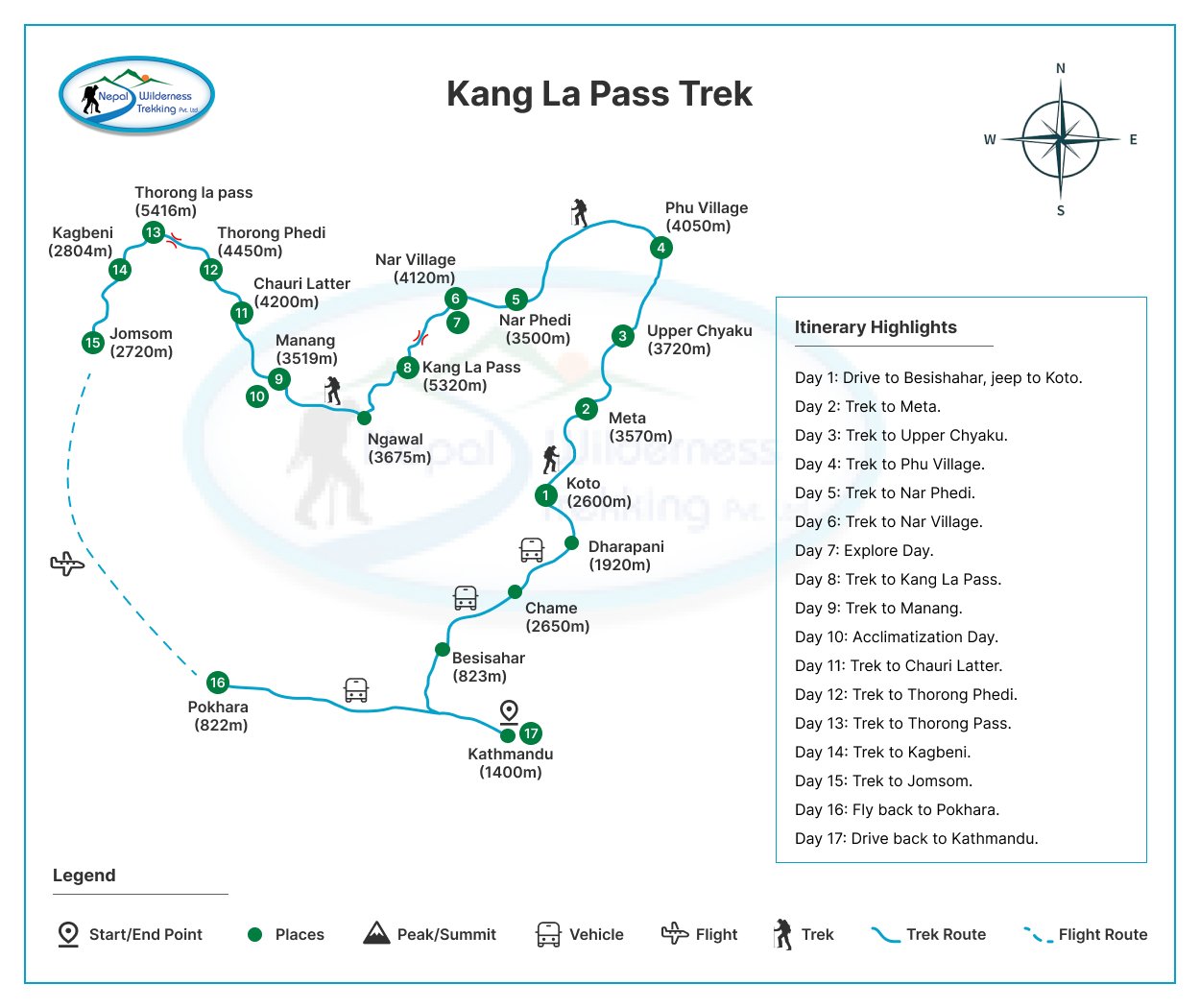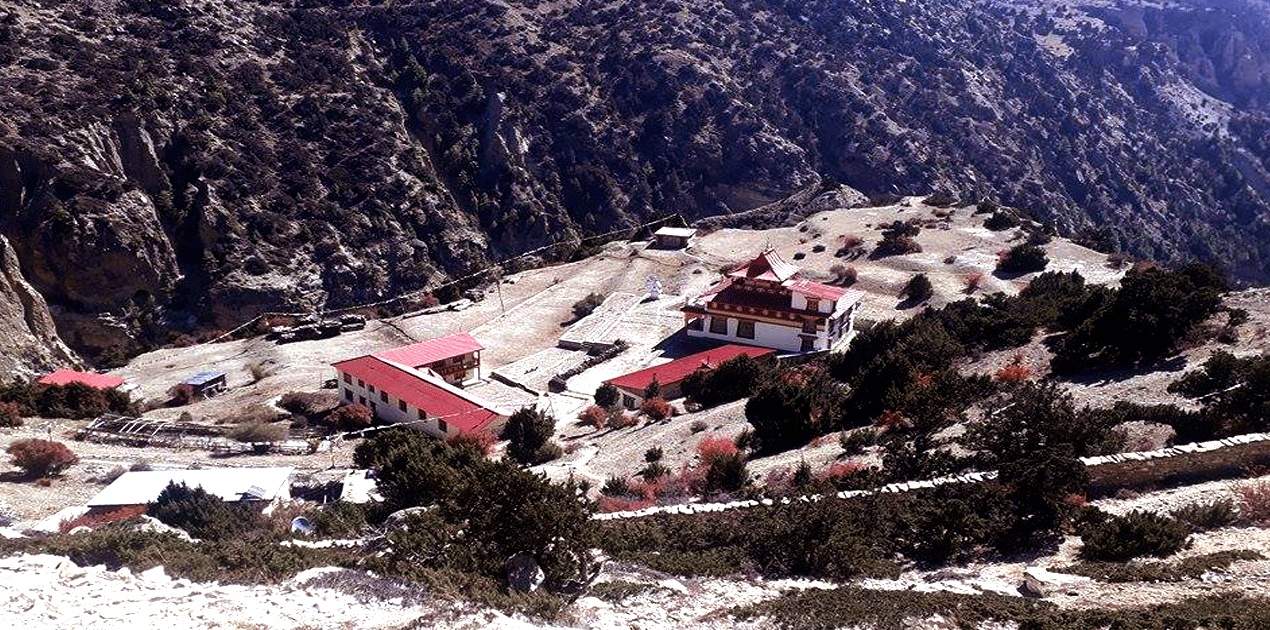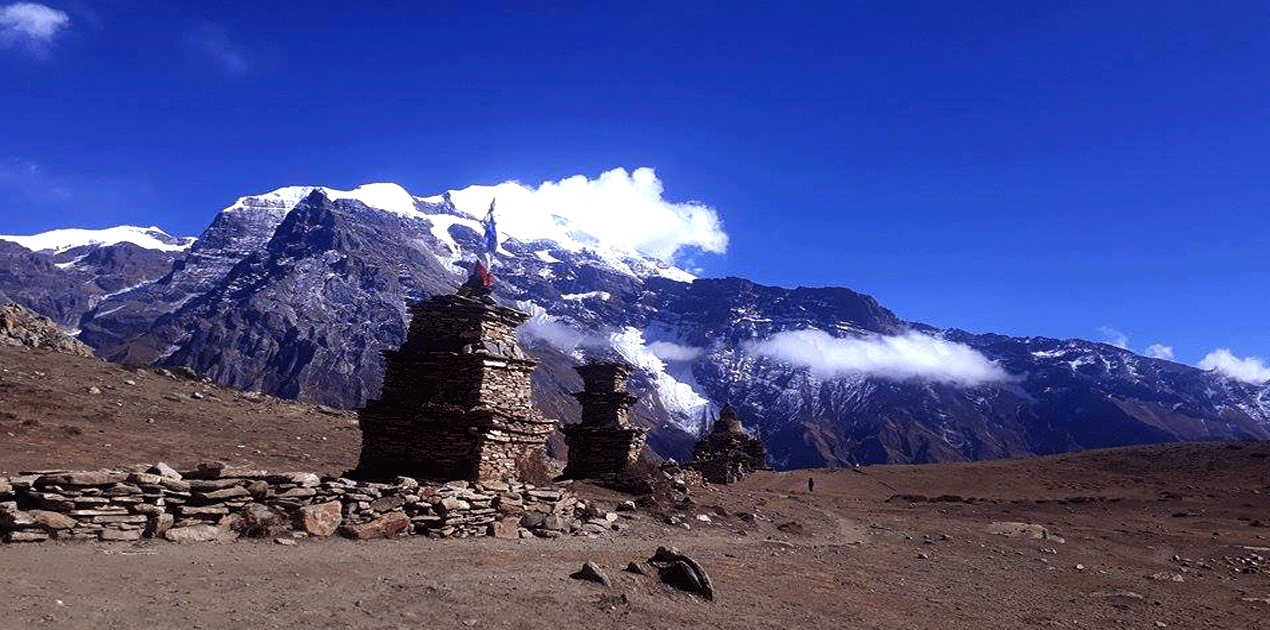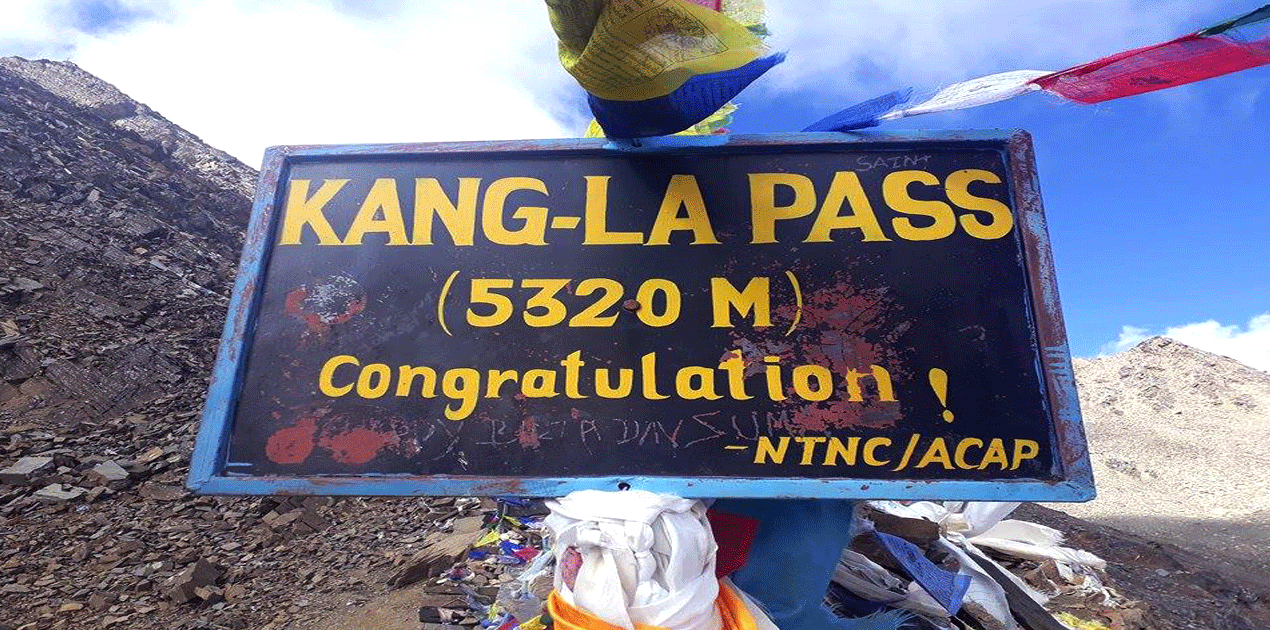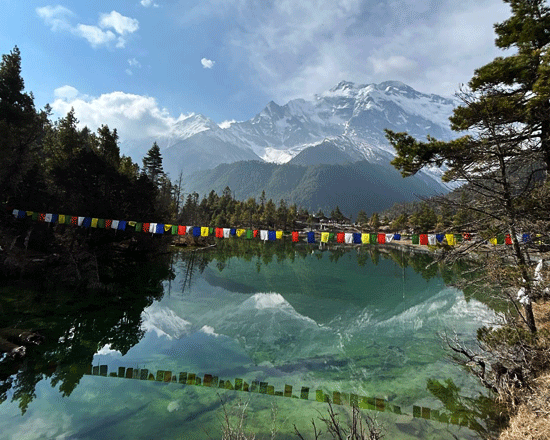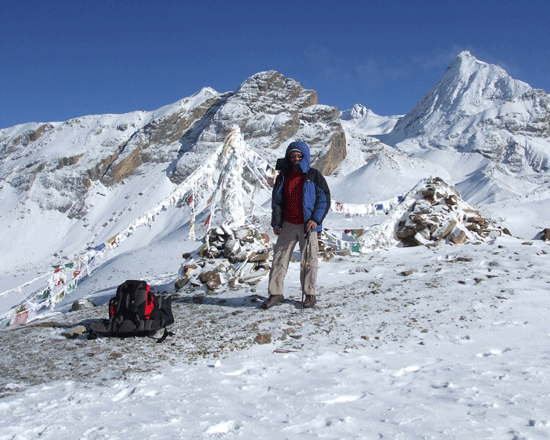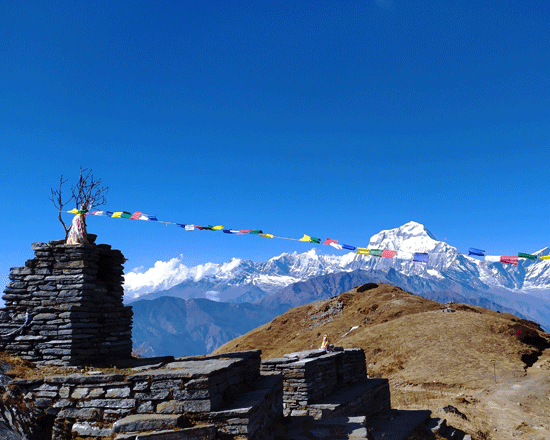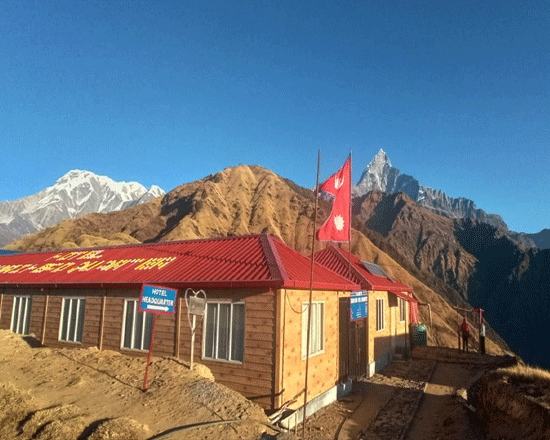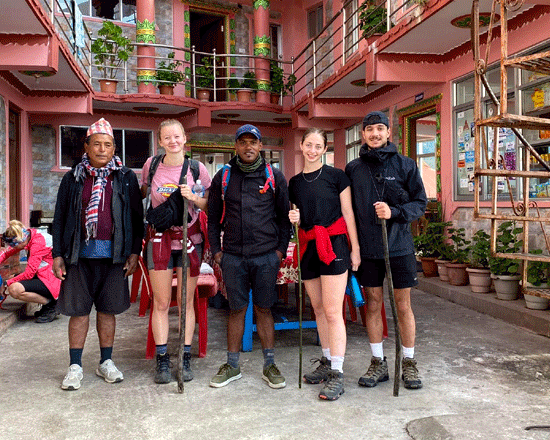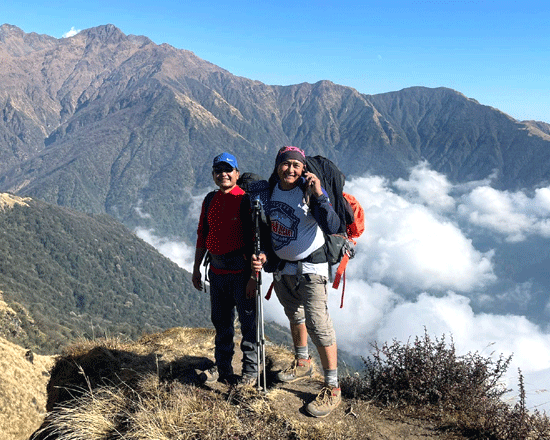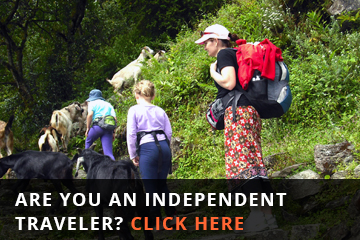Kang la Pass Trek
Kang la Pass Trek
Annapurna RegionTrip Facts
Since the terrain can be hard and the days long, hikers on these treks should be in good physical condition and have some previous mountain walking experience. Steep climbing may be involved, although it is never necessary to use ropes. Treks at this level can he arranged for periods of 16 to 21 days. Typically, a gradual ascent through a green river valley will lead you up to a number of high passes, where you will reach the altitude of 5416m. Often times, you will get a close insight into the Tibetan culture. Participants should expect to trek above 5416m/17872ft.
100%
Overview
Kang La Pass Trek: An In-Depth Exploration
The Kang La Pass Trek is a captivating and strenuous journey through the high-altitude terrains of the Annapurna region in Nepal. Standing at an elevation of 5,320 meters, the Kang La Pass offers trekkers an unparalleled opportunity to explore the breathtaking landscapes and rich cultural heritage of the Nar Phu Valley. Officially opened to adventurers in 2002 by King Mahendra, this trek is challenging yet rewarding with adventure, combining the Kang La Pass with the Thorong La Pass, culminating in a remarkable trekking experience.
Discover the Beauty of the Himalayas
Begin on the Kang La Pass trek allow you to witness the majestic beauty of the Annapurna Himalayas and immerse yourself in the Tibetan culture that permeates the region. This trek takes you through fertile planting spaces for Yarsagumba plants, which thrive in summer and winter. The panoramic views of Himlung Himal (7,126 meters) and Saribung Peak (6,345 meters) are awe-inspiring. Additionally, trekkers will encounter ancient Buddhist monasteries, the reincarnations of lamas (bodhisattvas), and the untouched hamlets of Nar and Phu Village.
Nar Phu Valley and Kang La Pass
The Kang La Pass Nar Phu Trek offers a rare glimpse into a region characterized by raw natural beauty and Tibetan culture that harkens back to a bygone era. This area is a living museum where children receive their education through Buddhist texts, and the historical Tashi Lhakhang Gompa stands as a testament to the region’s rich spiritual heritage. trekkers can receive blessings from Lama Karma Sonam Rinpoche, adding a deeply spiritual dimension to the journey.
The Cultural and Natural Highlights
The trek to the Nar Phu Valley is a journey through both cultural and natural marvels. The valley is home to the ancient villages of Nar and Phu, which are nestled amidst stunning landscapes. These villages offer a unique opportunity to experience traditional Tibetan culture, largely untouched by modernity. The ancient monasteries, prayer flags fluttering in the wind, and the sounds of monks chanting create an atmosphere of profound serenity.
The natural beauty of the region is equally captivating. The trail offers panoramic views of snow-capped peaks, deep gorges, and vast, barren landscapes. The flora and fauna of the area are diverse, with opportunities to see rare wildlife such as the elusive snow leopard and blue sheep.
The Challenge and Rewards of Kang La Pass Trek
The Kang La Pass trek is more challenging than the Thorong La Pass, with narrower trails and steep ascents. However, the spectacular views of Annapurna III, Gangapurna, Tilicho, Manaslu, Himlung, and Saribung Peaks make the effort worthwhile. Phu Village, situated at the junction of three passes—Teri La Pass, Saribung Pass via Upper Mustang, and Kang La Pass via Ngawel Manang—offers a unique cultural experience.
High Altitude Adventure
Trekking at high altitudes presents both challenges and rewards. To begin with, the ascent to the Kang La Pass is demanding, requiring physical endurance and acclimatization to prevent altitude sickness. However, the sense of achievement upon reaching the pass, combined with the stunning views of the surrounding peaks, is an unparalleled reward. Furthermore, the descent into the Nar Phu Valley is equally exhilarating, offering a sense of journeying into a hidden world.
Manang and the Annapurna Circuit
Manang village, a part of the Annapurna Circuit trek, is another highlight gem of the Kang La Pass trek. This beautiful trekker town offers opportunities to explore the Gangapurna Glacier and Tilicho Lake. The unique culture of Manang, with its traditional stone houses and Tibetan influences, adds to the trek’s richness. From Manang, the journey continues to the highest pass in Nepal, the Thorong La, standing at 5,416 meters above sea level. This part of the trek is a true test of endurance and offers some of the most breathtaking views of the entire Annapurna range.
Spiritual and Cultural Significance
The Kang La Pass trek is not just about physical challenges and natural beauty; but also a deeply spiritual journey. The region is dotted with ancient monasteries and gompas, each with its unique history and significance. The Tashi Lhakhang Gompa, for instance, is a revered site where trekkers can receive blessings from the local lama. The spiritual ambiance of the region, combined with the stunning natural beauty, creates a trek that is as enriching for the soul as it is for the body.
Organized by Nepal Wilderness Trekking Agency
Kang La Pass trekking is organized by the Nepal Wilderness Trekking team, which coordinates with local private guides who speak the native language and are fluent in English. These knowledgeable guides ensure a safe and enriching trekking experience. Additionally, for more information about trekking permits in the restricted zone, the agency provides comprehensive guidance and support.
Experienced Guides and Local Knowledge
One of the key advantages of trekking with the Nepal Wilderness Trekking Agency is the expertise of their guides. These guides are not only experienced trekkers but also have deep knowledge of the local culture, geography, and history. They enhance the trekking experience by providing insights into the region’s unique aspects and ensuring the safety and well-being of the trekkers.
Comprehensive Support and Logistics
The agency provides comprehensive support and logistics, ensuring that all necessary permits and arrangements are in place. This allows trekkers to focus on the journey without worrying about the administrative details. The support team also ensures that the trekkers have access to comfortable accommodations, nutritious meals, and any medical support if needed.
Conclusion
The Kang La Pass Trek offers an unforgettable adventure through the heart of the Annapurna region. From the raw beauty of the Nar Phu Valley to the challenging ascents of the Kang La and Thorong La Passes, this trek provides an unparalleled experience for those seeking both natural splendor and cultural immersion. With the support of experienced guides and the organization of Nepal Wilderness Trekking Agency, your journey through this high-altitude paradise will be one of the most rewarding adventures of your life.
In conclusion, the Kang La Pass trek is a journey of discovery, challenge, and spiritual enrichment. It offers trekkers a unique opportunity to explore one of the most beautiful and culturally rich regions of Nepal. Whether you are an experienced trekker or a novice adventurer, this trek promises an experience that will stay with you long after you have returned home.
Detail Itinerary
- Day 01: Start your journey by driving from Kathmandu to Besishahar, followed by a Jeep ride to Koto (2600 meters, 9 hours driving).
- Day 02: Trek from Koto to Meta (3570 meters, 7-8 hours walking).
- Day 03: Continue your trek from Meta to Upper Chyaku (3720 meters, 3-4 hours walking).
- Day 04: Trek from Upper Chyaku to Phu Village (4050 meters, 4-5 hours walking).
- Day 05: Move on to Nar Phedi from Phu Village (3500 meters, 6-7 hours walking).
- Day 06: Trek from Nar Phedi to Nar Village (4120 meters, 3-4 hours walking).
- Day 07: Explore the monasteries in Nar Village.
- Day 08: Trek from Nar to Kang La Pass (5320 meters), and then descend to Ngawal (3675 meters, 8-9 hours).
- Day 09: Trek to Manang (3341 meters, 5 hours walking) and stay overnight at a lodge.
- Day 10: Take a day off at the same location for acclimatization.
- Day 11: Continue the trek to Chauri Latter (3720 meters, 3/4 hours walking) and stay overnight at a lodge.
- Day 12: Trek to Thorong Phedi (3900 meters, 3 hours walking) and stay overnight at a lodge.
- Day 13: Begin your day early with a trek to Thorong Pass (5416 meters, 8 hours walking), then descend to Muktinath (3900 meters) and stay overnight at a lodge.
- Day 14: Trek to Kag Beni (3/4 hours walking) and overnight at the lodge.
- Day 15: Continue the trek to Jomsom (2743 meters, 4 hours walking) and stay overnight at a hostel.
- Day 16: Conclude your adventure with a flight back to Pokhara and stay overnight at a lakeside hotel.
- Day 17: Drive back to Kathmandu by tourist bus at 7:30 AM (200 km, 6/7 hours driving).
Cost Included
- Nar and Phu Restricted Area (NRA) Permits.
- Annapurna Conservation Area Permit.
- Trekker's Information Management System (TIMS) Card.
- One English-speaking experienced guide and required porters, with 1 porter for every 2 trekkers. Note that if a single trekker, there will be an additional cost for the porter.
- Bus from Kathmandu to Besisahar and a sharing jeep from Besisahar to Chamje.
- Flight from Jomsom to Pokhara.
- One-night hotel stay in Pokhara Lakeside.
- Tourist bus ticket from Pokhara to Kathmandu.
- All meals are provided (Breakfast, lunch, and dinner), along with seasonal fresh fruits after dinner.
- Lodge accommodation throughout the trek.
- Staff salaries, equipment, meals, insurance, and other related expenses.
- First Aid Kit.
- Kitbag for storing your belongings.
- Sleeping bag for a comfortable night's sleep in sub-zero temperatures.
- Necessary paperwork, including all government and local taxes.
- A certificate of appreciation from Nepal Wilderness Trekking after the successful completion of the trek.
Cost Excluded
- Airfare for international flights
- Upon arrival at Tribhuwan International Airport, Nepal entry visa fees vary by duration (15 days - $25-30, 30 days
- Accommodations in Kathmandu
- meals in Kathmandu and Pokhara before and after our journey
- Personal equipment for high and cold temperatures
- Emergency high-altitude rescue and evacuation are covered by travel insurance
- All beverages, Soft and caffeinated table drinks such as coke, beer,
- Drinking water/mineral water, Dessert, etc. Hot shower, laundry
- Tip for guide and porter
- Excluded are all costs and expenses not listed under "cost includes"
- Inclusion of costs or delays beyond the control of the management, such as landslides, weather conditions, itinerary modifications due to safety concerns, illness, changes in government policies, strikes, etc.
Trip Map
